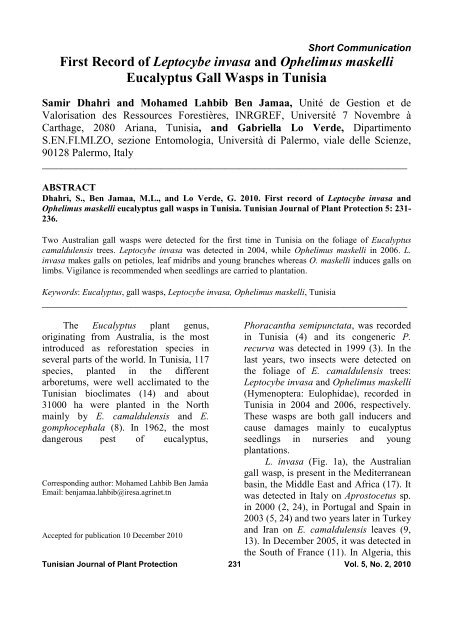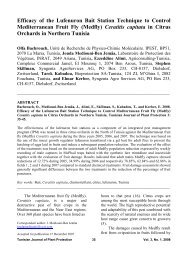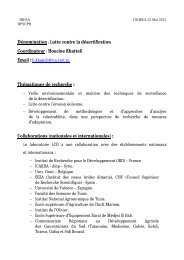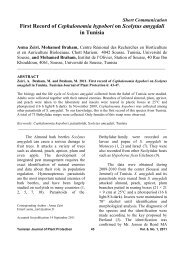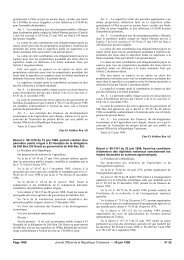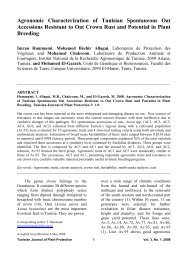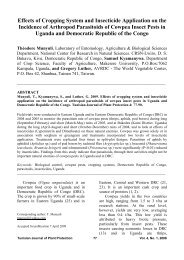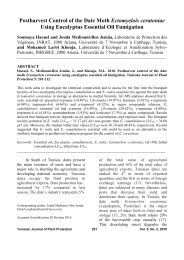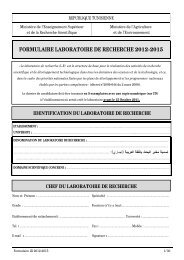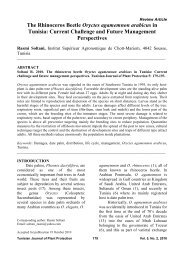First Record of Leptocybe invasa and Ophelimus maskelli ... - Iresa
First Record of Leptocybe invasa and Ophelimus maskelli ... - Iresa
First Record of Leptocybe invasa and Ophelimus maskelli ... - Iresa
You also want an ePaper? Increase the reach of your titles
YUMPU automatically turns print PDFs into web optimized ePapers that Google loves.
Short Communication<strong>First</strong> <strong>Record</strong> <strong>of</strong> <strong>Leptocybe</strong> <strong>invasa</strong> <strong>and</strong> <strong>Ophelimus</strong> <strong>maskelli</strong>Eucalyptus Gall Wasps in TunisiaSamir Dhahri <strong>and</strong> Mohamed Lahbib Ben Jamaa, Unité de Gestion et deValorisation des Ressources Forestières, INRGREF, Université 7 Novembre àCarthage, 2080 Ariana, Tunisia, <strong>and</strong> Gabriella Lo Verde, DipartimentoS.EN.FI.MI.ZO, sezione Entomologia, Università di Palermo, viale delle Scienze,90128 Palermo, Italy__________________________________________________________________________ABSTRACTDhahri, S., Ben Jamaa, M.L., <strong>and</strong> Lo Verde, G. 2010. <strong>First</strong> record <strong>of</strong> <strong>Leptocybe</strong> <strong>invasa</strong> <strong>and</strong><strong>Ophelimus</strong> <strong>maskelli</strong> eucalyptus gall wasps in Tunisia. Tunisian Journal <strong>of</strong> Plant Protection 5: 231-236.Two Australian gall wasps were detected for the first time in Tunisia on the foliage <strong>of</strong> Eucalyptuscamaldulensis trees. <strong>Leptocybe</strong> <strong>invasa</strong> was detected in 2004, while <strong>Ophelimus</strong> <strong>maskelli</strong> in 2006. L.<strong>invasa</strong> makes galls on petioles, leaf midribs <strong>and</strong> young branches whereas O. <strong>maskelli</strong> induces galls onlimbs. Vigilance is recommended when seedlings are carried to plantation.Keywords: Eucalyptus, gall wasps, <strong>Leptocybe</strong> <strong>invasa</strong>, <strong>Ophelimus</strong> <strong>maskelli</strong>, Tunisia__________________________________________________________________________The Eucalyptus plant genus, Phoracantha semipunctata, was recordedoriginating from Australia, is the most in Tunisia (4) <strong>and</strong> its congeneric P.introduced as reforestation species in recurva was detected in 1999 (3). In theseveral parts <strong>of</strong> the world. In Tunisia, 117 last years, two insects were detected onspecies, planted in the different the foliage <strong>of</strong> E. camaldulensis trees:arboretums, were well acclimated to the <strong>Leptocybe</strong> <strong>invasa</strong> <strong>and</strong> <strong>Ophelimus</strong> <strong>maskelli</strong>Tunisian bioclimates (14) <strong>and</strong> about (Hymenoptera: Eulophidae), recorded in31000 ha were planted in the North Tunisia in 2004 <strong>and</strong> 2006, respectively.mainly by E. camaldulensis <strong>and</strong> E. These wasps are both gall inducers <strong>and</strong>gomphocephala (8). In 1962, the most cause damages mainly to eucalyptusdangerous pest <strong>of</strong> eucalyptus, seedlings in nurseries <strong>and</strong> youngplantations.L. <strong>invasa</strong> (Fig. 1a), the Australiangall wasp, is present in the MediterraneanCorresponding author: Mohamed Lahbib Ben Jamâa basin, the Middle East <strong>and</strong> Africa (17). ItEmail: benjamaa.lahbib@iresa.agrinet.tnwas detected in Italy on Aprostocetus sp.in 2000 (2, 24), in Portugal <strong>and</strong> Spain in2003 (5, 24) <strong>and</strong> two years later in TurkeyAccepted for publication 10 December 2010<strong>and</strong> Iran on E. camaldulensis leaves (9,13). In December 2005, it was detected inthe South <strong>of</strong> France (11). In Algeria, thisTunisian Journal <strong>of</strong> Plant Protection 231 Vol. 5, No. 2, 2010
pest was added at the alert list by theOEPP in 2006 (12). Thelytokousparthenogenetic reproduction is typical <strong>of</strong>L. <strong>invasa</strong> female (Fig. 1a), 1.1-1.4 mm inlength (17). It induces galls on petioles,leaf midribs <strong>and</strong> young branches <strong>of</strong>several Eucalyptus species such as E.camaldulensis, E. tereticornis, E. rudis,E. gr<strong>and</strong>is, E. globulus <strong>and</strong> E. viminalis(Fig. 1b). Developmental stages <strong>of</strong> thewasp proceed into the gall <strong>of</strong> a meanlength <strong>of</strong> 2.1 mm (17). Galls taken at theend <strong>of</strong> May 2007 from E. camaldulensistree <strong>and</strong> cut up showed mature larva <strong>and</strong>nymph stages (Fig. 1c,d) <strong>and</strong> in the sameday we noted the emergence <strong>of</strong> the adult(Fig.1e). Mendel et al. (17) indicated thatunder laboratory conditions, this wasplasts 132.6 days from oviposition to adultemergence <strong>and</strong> may produce two or threegenerations annually. Intense infestationscan lead to deformations <strong>of</strong> the leaves <strong>and</strong>young stems <strong>and</strong> to reduction <strong>of</strong> treegrowth. In Middle East, Turkey <strong>and</strong> Italytwo Megastigmus species are reported asparasitoids <strong>of</strong> L. <strong>invasa</strong> (21, 26).Fig. 1. Female <strong>of</strong> L. <strong>invasa</strong> (a), galls <strong>of</strong> L. <strong>invasa</strong> on E. camaldulensis (b), gall cut up showing mature larva (c),gall cut up showing nymph (d) <strong>and</strong> adult <strong>of</strong> L. <strong>invasa</strong> emerging from the gall (e).O. <strong>maskelli</strong> (Fig. 2a) was reported inthe last decade from many Mediterraneanareas <strong>and</strong> was firstly identified, in Italy<strong>and</strong> Northeast Spain, as O. eucalypti (1,22, 23, 26). In 2003, this pest wasTunisian Journal <strong>of</strong> Plant Protection 232reported in the Middle East <strong>and</strong> Spain(19, 24). In 2005, it was reported from theSouth <strong>of</strong> France (11) <strong>and</strong> in 2006, inPortugal <strong>and</strong> Turkey (6, 10). Thiseulophid induces galls on the limb <strong>of</strong>Vol. 5, No. 2, 2010
leaves <strong>of</strong> several Eucalyptus species suchas E. camaldulensis, E. tereticornis, E.rudis, E. gr<strong>and</strong>is, E. cinerea, E. robusta,E. botyoides, E. viminalis, <strong>and</strong> E. saligna(Fig. 2b). Female, <strong>of</strong> 0.83 to 1.07 mm inlength lays about 100 eggs with apreference next to petiole, but in heavilyattack all the leaf surface is covered withgalls with a density reaching 36 galls/cm 2(19).The laying causes the beginning <strong>of</strong>the formation <strong>of</strong> galls containing only onelarva (Fig. 2c). The larva pupates (Fig.2d) inside the gall with a diameter <strong>of</strong> 0.9to 1.2 mm (21), then the adult emerges.After emergence, heavily attacked leavesbecome desiccated <strong>and</strong> fall leading to adelay <strong>of</strong> development <strong>and</strong> a loss <strong>of</strong> thestrength <strong>of</strong> the trees. For the biologicalcontrol <strong>of</strong> this pest, the parasitoidClosteroceruschamaeleon(Hymenoptera: Eulophidae), wasintroduced in the Middle East (18) <strong>and</strong> insome Italian regions (6, 15, 23). Thisparasitoid was also detected in Turkey(10) <strong>and</strong> in Tunisia (16).Fig. 2. Female O. <strong>maskelli</strong> laying eggs (a), galls <strong>of</strong> O. <strong>maskelli</strong> on E. camaldulensis leaves (b), galls cut upshowing larvae <strong>of</strong> O. <strong>maskelli</strong> (c) <strong>and</strong> galls cut up showing pre-nymph (right) <strong>and</strong> nymph (left) (d).Tunisian Journal <strong>of</strong> Plant Protection 233Vol. 5, No. 2, 2010
E. camaldulensis seems to be moreattacked than the other Eucalyptus species<strong>and</strong> heavy infestations, reaching 100% <strong>of</strong>attacked seedlings, were reported mainlyin young plantations <strong>and</strong> nurseryseedlings <strong>of</strong> this species. Currently, nocontrol measures are available againstboth species, even if the parasitingactivity <strong>of</strong> Closterocerus chamaeleonseems to effectively reduce the infestationlevels <strong>of</strong> O. <strong>maskelli</strong> (7, 25). However,more precautions would be needed whenexchanging eucalyptus plants forplanting, enhancing the level <strong>of</strong>monitoring <strong>and</strong> carrying out research inarboretums to identify Eucalyptus specieswhich resist to this gall wasp.__________________________________________________________________________RESUMEDhahri S., Ben Jamaa M.L. et Lo Verde G. 2010. Première observation de <strong>Leptocybe</strong> <strong>invasa</strong> et<strong>Ophelimus</strong> <strong>maskelli</strong> insectes gallicoles d’eucalyptus en Tunisie. Tunisian Journal <strong>of</strong> PlantProtection 5: 231-236.Deux espèces australiennes d’insectes gallicoles ont été détectées pour la première fois en Tunisie surle feuillage des arbres d’Eucalyptus camaldulensis: <strong>Leptocybe</strong> <strong>invasa</strong> observée en 2004 et <strong>Ophelimus</strong><strong>maskelli</strong> en 2006. L. <strong>invasa</strong> provoque des galles sur les pétioles, la nervure principale de la feuille et lesjeunes pousses t<strong>and</strong>is que O. <strong>maskelli</strong> induit des galles au niveau des limbes. Une vigilance estrecomm<strong>and</strong>ée au niveau du transport des plants d’une région à une autre.Mots clés: Eucalyptus, insectes gallicoles, <strong>Leptocybe</strong> <strong>invasa</strong>, <strong>Ophelimus</strong> <strong>maskelli</strong>, Tunisia__________________________________________________________________________ملخصظاهري، سمير ومحمد لحبيب بن جامع وغابريالا لو فيردي.وأوّل تسجيل لدبوري التدرن<strong>Leptocybe</strong> <strong>invasa</strong>.2010<strong>Ophelimus</strong> على أشجار الأوآالبتوس في تونس.Tunisian Journal <strong>of</strong> Plant Protection 5: 231-236.<strong>maskelli</strong>تمتم لأوّل مرّة في تونس تسجيل دبورين أستراليين على أوراق أشجار الأوآالبتوسفي سنة يسبب انتفاخًا علىفي سنةآشفمستوى العنق والعرق الرئيسي للورقة والأغصان الفتية. أمّا فإنه يحدث انتفاخا على النّصل. يوصى باليقظةالمستمرة وبخاصة أثناء نقل الشتلات الحراجية/الغابية إلى أماآن زراعتها.:Eucalyptus camaldulensisL. <strong>invasa</strong> .20062004 و <strong>Ophelimus</strong> <strong>maskelli</strong>O. <strong>maskelli</strong><strong>Leptocybe</strong> <strong>invasa</strong>آلمات مفتاحية: أوآالبتوس، تونس، دبابير التدرن،<strong>Leptocybe</strong> <strong>invasa</strong> ،<strong>Ophelimus</strong> <strong>maskelli</strong>___________________________________________________________________________LITERATURE CITED1. Arzone, A. <strong>and</strong> Alma, A. 2000. Eul<strong>of</strong>idegalligeno dell’Eucalipto in Italia. Infor. Fitopat.50: 43-46.2. Bella, S. <strong>and</strong> Lo Verde, G., 2002. Presenzanell’Italia Continentale e in Sicilia di <strong>Ophelimus</strong>prope eucalypti (Gahan) e Aprostocetus sp.,galligeni degli Eucalipti (HymenopteraEulophidae). Naturalista Sicil. S. IV 26: 191-197.3. Ben Jamâa, M.L. Villemant, C., et M’nara, S.2002. Phoracantha recurva Newman, 1840(Coleoptera, Cerambycidae): un nouveauravageur des Eucalyptus en Tunisie. Rev. Fr.Entomol. 24: 19-21.4. Billioti, E. et Schoenenberger, A. 1962. Sur laprésence en Tunisie de Phoracantha semipunctataFab. (Coleoptera, Cerambycidae) ravageur del’Eucalyptus. Ann. INRAT 35: 97-109.Tunisian Journal <strong>of</strong> Plant Protection 234 Vol. 5, No. 2, 2010
5. Branco, M., Boavida, C., Dur<strong>and</strong>, N., Franco,J.C., <strong>and</strong> Mendel Z. 2009. Presence <strong>of</strong> theEucalyptus gall wasp <strong>Ophelimus</strong> <strong>maskelli</strong> <strong>and</strong> itsparasitoid Closterocerus chamaeleon in Portugal:<strong>First</strong> record, geographic distribution <strong>and</strong> hostpreference. Phytoparasitica 37: 51-5415. Laudonia, S., Viggiani, G., <strong>and</strong> Sasso, R. 2006.Parassitoide esotico in aiuto degli eucalipti.Inform. Agr. 40: 74.16. Lo Verde, G., Dhahri, S., <strong>and</strong> Ben Jamâa, M.L.2010. <strong>First</strong> record in Tunisia <strong>of</strong> Closteroceruschamaeleon (Girault) parasitoid <strong>of</strong> the Eucalyptus6. Branco, M., Franco, J.C., Valente, C., <strong>and</strong>Gall Wasp <strong>Ophelimus</strong> <strong>maskelli</strong> (Ashmead)Mendel, Z. 2006. Survey <strong>of</strong> Eucalyptus gall wasps(Hymenoptera: Eulophidae) in Portugal. Boletínde Sanidad Vegetal, Plagas 32: 199-202.7. Caleca, V., Rizzo, M.C., Lo Verde, G., Rizzo, R.,Buccellato, V., Luciano, P., Cao, O., Palmeri, V.,Gr<strong>and</strong>e, S.B., <strong>and</strong> Campolo, O. 2009. Diffusionedi Closterocerus chamaeleon (Girault) introdottoin Sicilia, Sardegna e Calabria per il controllobiologico di <strong>Ophelimus</strong> <strong>maskelli</strong> (Ashmead)(Hymenoptera, Eulophidae), galligeno esotico(Hymenoptera Eulophidae). Naturalista sicil., S.IV 34: 207-210.17. Mendel, Z., Protasov, A., Blumberg, D., Br<strong>and</strong>,D., Saphir, N., Madar, Z., <strong>and</strong> La Salle, J. 2007.Release <strong>and</strong> recovery <strong>of</strong> parasitoids <strong>of</strong> theEucalyptus gall wasp <strong>Ophelimus</strong> <strong>maskelli</strong> inIsrael. Phytoparasitica 35: 330-332.18. Mendel, Z., Protasov, A., Fisher, N., <strong>and</strong> LaSalle, J. 2004. Taxonomy <strong>and</strong> biology <strong>of</strong><strong>Leptocybe</strong> <strong>invasa</strong> gen. & sp. n. (Hymenoptera:sugli eucalipti. Atti III Congr. Nazionale diEulophidae), an invasive gall inducer onSelvicoltura, Taormina 16-19 ottobre 2008 Acc.Ital. Sc. Forestali, Taormina - Me- (ITA), Vol. II:638-642.Eucalyptus. Aust. J. Entomol. 43: 51-63.19. Protasov, A., Blumberg, D., Br<strong>and</strong>, D., La Salle,J., <strong>and</strong> Mendel, Z. 2007a. Biological control <strong>of</strong> the8. Direction Générale des Forêts. 2005. Résultats dugall wasp <strong>Ophelimus</strong> <strong>maskelli</strong> (Ashmead):deuxième inventaire forestier et pastoral national,Taxonomy <strong>and</strong> biology <strong>of</strong> the parasitoid speciesMinistère de l’Agriculture, des RessourcesClosterocerus chamaeleon (Girault), withHydrauliques et de la Pêche Tunisie, 129 pp.9. Doganlar, O. 2005. Occurrence <strong>of</strong> <strong>Leptocybe</strong>information on its establishment in Israel.Biological Control 42: 196-206.<strong>invasa</strong> Fisher & La Salle, (Hymenoptera: 20. Protasov, A., Doganlar, M., La Salle, J., <strong>and</strong>Chalcidoidea) on Eucalyptus camaldulensis inTurkey, with a description <strong>of</strong> the male sex. Zool.Middle East 35: 112-114.10. Doganlar, O. <strong>and</strong> Mendel, Z. 2007. <strong>First</strong> record<strong>of</strong> the Eucalyptus gall wasp <strong>Ophelimus</strong> <strong>maskelli</strong><strong>and</strong> its parasitoid, Closterocerus chamaeleon, inTurkey. Phytoparasitica 35: 333-335.11. European <strong>and</strong> Mediterranean Plant ProtectionMendel, Z. 2008. Occurrence <strong>of</strong> two localMegastigmus species parasitic on the Eucalyptusgall wasp <strong>Leptocybe</strong> <strong>invasa</strong> in Israel <strong>and</strong> Turkey.Phytoparasitica 36: 449-459.21. Protasov, A., La Salle, J., Blumberg, D., Br<strong>and</strong>,D., Saphir, N., Assael, F., Fisher, N., <strong>and</strong> Mendel,Z. 2007b. Biology, revised taxonomy <strong>and</strong> impacton host plants <strong>of</strong> <strong>Ophelimus</strong> <strong>maskelli</strong>, an invasiveOrganization. 2006. <strong>First</strong> report <strong>of</strong> two newgall inducer on Eucalyptus spp. in theeucalyptus pests in the south <strong>of</strong> France:Mediterranean Area. Phytoparasitica 35: 50-76.<strong>Ophelimus</strong> <strong>maskelli</strong> <strong>and</strong> <strong>Leptocybe</strong> <strong>invasa</strong>. EPPOReporting Service 9: 9.12. European <strong>and</strong> Mediterranean Plant ProtectionOrganization. 2006. Addition <strong>of</strong> <strong>Leptocybe</strong> <strong>invasa</strong>to the alert list. EPPO Reporting Service 9: 10.22. Pujade-Villar, J. <strong>and</strong> Riba-Flinch, J.M. 2004.Dos especies australianas de eulófidos, muydañinas para Eucalyptus spp., introducidas en elnordeste ibérico (Hymenoptera: Eulophidae).Boln. S.E.A. 35: 299-301.13. Hesami, S., Alemansoor, H., <strong>and</strong> 23. Rizzo, M.C., Lo Verde, G., Rizzo, R.,Seyedebrahimi, S. 2005. Report <strong>of</strong> <strong>Leptocybe</strong>Buccellato, V., <strong>and</strong> Caleca, V. 2006. Introduzione<strong>invasa</strong> (Hym.: Eulophidae), gall wasp <strong>of</strong>di Closterocerus sp. in Sicilia per il controlloEucalyptus camaldulensis with notes on biologybiologico di <strong>Ophelimus</strong> <strong>maskelli</strong> Ashmeadin Shiraz vicinity. J. Entomol. Soc. Iran 24: 99-108.14. Khouja, M.L., Khaldi, A., <strong>and</strong> Rjeb, M.N. 2001.Results <strong>of</strong> the eucalyptus introduction trials inTunisia. Pages 163-168. Proceeding <strong>of</strong> theInternational Conference on Eucalyptus in theMediterranean Basin: Perspectives <strong>and</strong> New(Hymenoptera Eulophidae) galligeno esotico sugliEucalipti. Boll. Zool. Agr. Bachic. 38: 237-248.24. Sánchez, I. 2003. Descubiertas dos nuevasplagas del eucalipto en España. Quercus 214: 32-33.25. Sasso, R., Laudonia, S., <strong>and</strong> Viggiani, G. 2008.Dati preliminari per il controllo biologico diUtilization. October 15-19, 2000, Centro<strong>Ophelimus</strong> <strong>maskelli</strong> (Ashmead) (Hymenoptera:Promozione Pubblicità, Florence, Taormina -Eulophidae) in Campania a seguitoItaly.dell’introduzione del suo antagonistaClosterocerus chamaeleon (Girault)Tunisian Journal <strong>of</strong> Plant Protection 235 Vol. 5, No. 2, 2010
(Hymenoptera: Eulophidae). Boll. Zool. Agr.Bachic. F. 62: 51-55.26. Viggiani, G., Laudonia, S., <strong>and</strong> Bernardo, U.2002. Aumentano gli insetti dannosi agli eucalipti.Inform. Agr. 12: 86-87.27. Viggiani, G. <strong>and</strong> Nicotina, M. 2001. L’Eul<strong>of</strong>idegalligeno fogliare degli eucalipti <strong>Ophelimus</strong>eucalypti (Gahan) (Hymenoptera: Eulophidae) inCampania. Boll. Zool. Agr. Bachic. 33: 79-82.----------------------Tunisian Journal <strong>of</strong> Plant Protection 236 Vol. 5, No. 2, 2010


